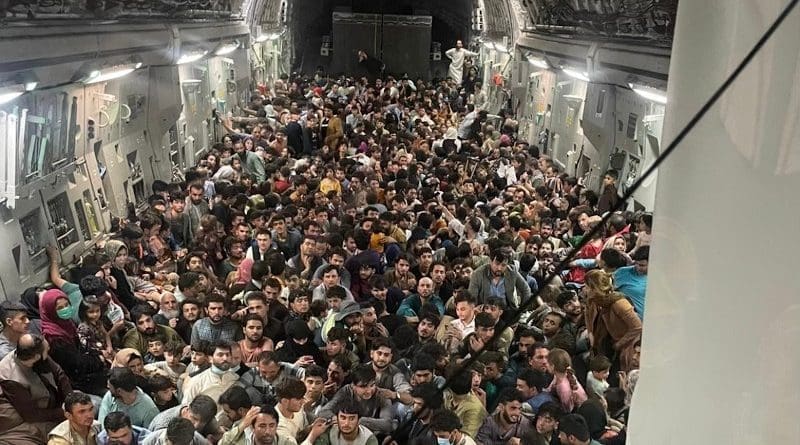Afghan Taliban And Fall Of Kabul: Rhetoric, Realities And A Restive Afghanistan – Analysis
By Institute of South Asian Studies
By Imran Ahmed*
In recent months, the Afghan Taliban have sought to present a careful diplomatic face to the movement through a series of high-profile engagements with neighbouring states and regional powers. The Taliban have reassured its international critics that its intentions are for peace and prosperity in Afghanistan, rebuilding the war-torn state, re-evaluating the place of women as well as ensuring the safety and security of other states. The Taliban have sought to reconstruct their image as a movement seeking to bring law and order into a country torn apart by war, corruption and lawlessness. It now also features a powerful online and social media presence, and its Qatar office serves as its media voice spelling out the movement’s position on an array of thorny political, social and diplomatic issues through press releases, tweets and news interviews.
Militarily, the speed of Taliban’s takeover of Afghanistan has been unprecedented and experts have reported the composition of fighters has changed. The Taliban have gone from a Pashtun-majority group to a movement which now attracts other ethnicities. There is also notable coherence and unity within the leadership of the group. This notably contrasts with the factional in-fighting which divided the movement following the death of Mullah Omar.
These developments of a seemingly modernised, unified, more heterogenous and moderate Taliban seeking international approval and vying for political legitimacy raises the question of whether this is a new Taliban altogether – at least, ideologically.
The ground realities of the war seem to suggest otherwise. While the Taliban’s diplomatic fervour might surprise some, more provoking is its guarantees to stamp out and distance itself from other Islamist militant groups that pose security challenges to China, Russia and the Central Asian states. However, there is little evidence to suggest that the Taliban have cut ties with Al Qaeda or the Islamic State of Iraq and the Levant (ISIS/ISIL). The group promised to not attack provincial Afghan cities while its soldiers on the ground besieged them. In its campaign of violence, the group has shown little regard for political agreements, international law, human rights or the rights of women, children or prisoners of war.
The Taliban have specifically targeted journalists, critics and media outlets. More than 1,000 civilians have been killed due to indiscriminate attacks in Helmand, Kandahar and Herat provinces in the past month alone. The group has shown little regard for the human cost of the war and their repression of women’s rights and freedoms and sexual violence towards unmarried women and girls continue. The force of their violent intolerance towards religious difference remains unhindered. Attacks on the Hazaras, Sikhs, Hindus and other religious minorities have been most alarming.
Those seeking to rebrand the group appear to do so out of their own designs and interests. Pakistan has facilitated in the Taliban’s image makeover. Its Interior Minister, Sheikh Rashid Ahmed, described the militant group as the “new, civilised Afghan Taliban”. Prime Minister Imran Khan referred to the Taliban not as a military outfit, but as “normal civilians”. A Taliban victory is a win for Islamabad and Rawalpindi’s long game in shaping an Afghan regime sympathetic to Pakistan’s security interests. Moreover, fashioning the Taliban as a legitimate governing contender also serves the interest of the United States (US). The appearance of a more moderate Taliban improves the optics of a hasty US retreat and America’s responsibility towards the Afghan people.
The fall of Kabul on the weekend presents the challenge of forming government and that of governance for the Taliban: areas, unlike their military capabilities, they have shown little aptitude in the past. As the ruling regime, their mandate is also unpopular. The most comprehensive survey of Afghanistan reveals that the vast majority of the population have no sympathy for the Taliban. Moreover, the rapid takeover of the country demonstrates as much about American strategic miscalculations and the former Afghan government’s incompetence, as it does about the swift and fluid nature of shifting loyalties and allegiances. When the dust settles, the coming days will reveal the strength of the Taliban’s hold on power as they grapple with ruling a restive Afghanistan.
*About the author: Dr Imran Ahmed is a Visiting Research Fellow at the Institute of South Asian Studies (ISAS), an autonomous research institute at the National University of Singapore (NUS). He can be contacted at [email protected]. The author bears full responsibility for the facts cited and opinions expressed in this paper.
Source: This article was published by Institute of South Asian Studies (ISAS)

